. . . to this channel: great things are just around the corner!
Beer Gadgeteer and the Fabulous Fizzbuster
File this one under ‘Oh lord, what now?’
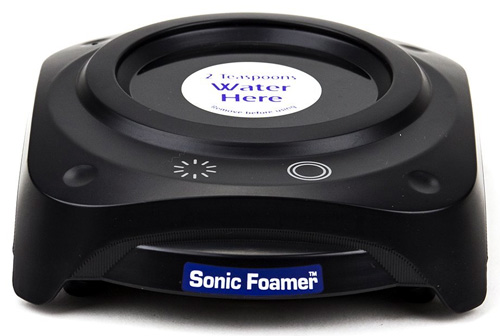
If you’re having trouble guessing what the gadget is, don’t feel bad: other than the strange label (which makes it sound like it’s for shaving cream or perhaps for cartoon hedgehogs) there’s nothing about it that suggests a function. My first thought was that it was for rewinding DVD’s. However, according to the website,
Using ultrasonic vibrations, the Sonic Foamer excites the gases in your beer for an amazingly creamy head.
Oh. Okay. I can do the same thing by pouring the beer between two glasses, or stirring it with a spoon for a second, but sure, make an expensive gadget for stirring-impaired people, no problem. But why do they think you should stir it up and make a foamy head?
The aroma of a beer is released as the bubbles in the head pop.
No, that is not how the aroma in a beer is released. The aroma in a beer is released when the low-weight molecular compounds that comprise the bouquet and aroma of the beer travel from the liquid and travel through the air to the receptors in your nose. Bursting bubbles in the head aren’t especially relevant to the process.
Certainly, agitating the liquid helps increase the amount of these compounds released–that’s why wine tasters swirl their glasses. And beer judges do the very same thing, swirling sample glasses to chase out elusive aromas.
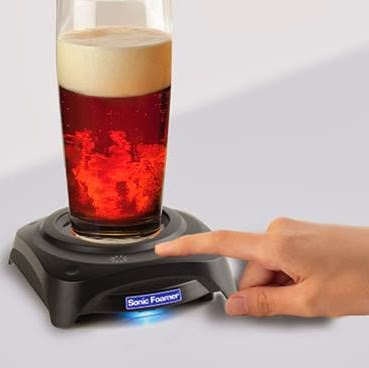
So it’s a gadget that’s a solution to a problem that exists in the minds of their marketing department. C’est la guerre. But even though their claims are malarkey, I can think of a brilliant use for one of these doohickeys: degassing excessively foamy beer.
This is a pet peeve of mine. Anyone who has gone on a pub crawl with me has had to watch me restlessly pour my beer between two glasses to chase off three-quarters of the carbon dioxide gas before I drink it. I don’t do it to all styles, because some styles like wheat beer, Kolsch and light lager need sufficient volumes of CO2 for proper mouthfeel.
‘Volume’ is the science-word for amount of gas in a liquid solution. The actual sciencey part of beer carbon dioxide saturation is governed by Henry’s Law and a bunch of frightening math. For our purposes, one volume of CO2 is the equivalent of one litre of carbon dioxide gas dissolved in one litre of beer at one atmosphere of pressure (sea-level, more-or-less). If you’re not metric, a litre is about a quart. If you’re having trouble conceptualising what this means, if you drink a litre of one-volume beer, you’re going to belch out one litre of burps, eventually.
A classic Czech Pilsner will have 2.3-2.5 volumes, very appropriate for that style, while Standard Western Industrial Light Lager will have 2.7+ volumes. That’s only fair since it doesn’t generally have any other character to speak of.
Where this all falls apart for me is ales. Classic British pale ales will have 0.75 to 1.3 volumes. If you’re a fan of these beers, they drink smooth and taste wonderful, and you don’t have to belch like a foghorn if you decide to have several pints. American ale styles on the other hand, have as much CO2 as lagers. American Pale Ale clocks in at up to 2.78 volumes, making the much heavier, more flavourful style of beer as gassy and belch-worthy as lawnmower S.W.I.L.L.
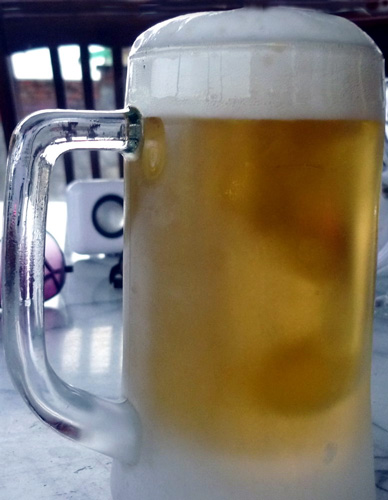
For my palate, this destroys the flavour, mouthfeel and enjoyability of the beer. CO2 gas in solution produces carbonic acid, a flat, bitter tasting substance which dulls the bright flavours in the beer, and it makes me feel bloated and belchy after only a couple of pints. I keep questioning brewers as to why they continue to overcarbonate their beer like it’s a practical joke drink but the standard reply is, ‘That’s what consumers expect’.
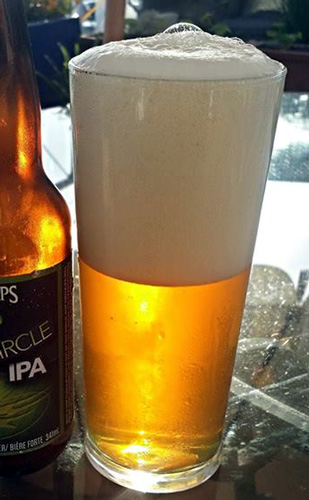
Some day I’m going to punch those consumers in the snoot, because they just don’t seem to know what’s good for them. If they tried the beer at a proper carbonation level they’d find it much more interesting and drinkable. Maybe some day. Until then I’ll have to content myself with making my own beer and carbonating it to the levels I like, degassing commercial beers right at the bar, and complaining about how everyone is wrong about everything except me.
But I’m thinking I need to order me one o’ those de-foamers to do a little testing . . .
Neuroanthropology, Beer, and Business
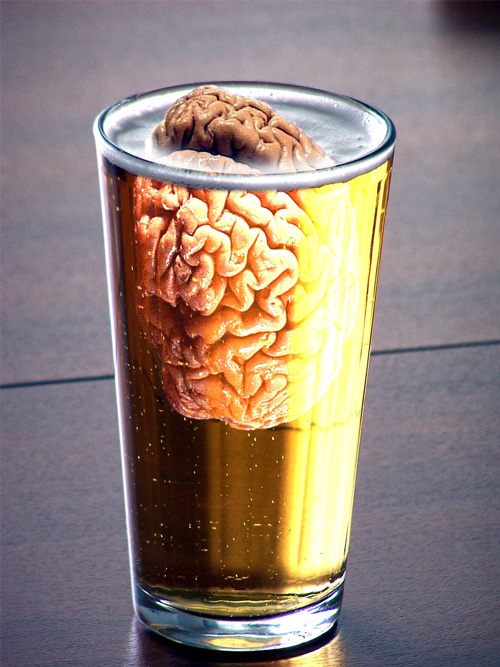
According to the Wikipedia, neuroanthropology is the study of culture and the brain. What is beer, if not culture, I always say, and yet it was a pleasant surprise to see the fellows over at the Public Library of Science Blogs saying the same thing in an entry, Carefully Crafting Consumption: Understanding the Craft Beer Revolution, where they examine (and get some experimental data on) ‘What are the driving forces behind the increased popularity of craft beer?’
It’s a good and timely question: over 400 new craft breweries opened in the last year in the USA. In my home of British Columbia we’re getting something like thirty new craft breweries a year right now–and it’s picking up every day.
Why are people so hot on craft beer–particularly at a time when macro beers (the pale, fizzy stuff that requires advertising on television) are declining precipitously? It’s so bad for the major breweries right now that they’re on incredibly aggressive acquisition schedules, buying foreign premium breweries (such as Becks) and then tossing the recipes and filling the pretty ‘imported’ bottles with BudMillerCoors Standard Western Industrial Light Lager (S.W.I.L.L.) It’s not doing them any good, mind: as soon as they acquire and ruin a new brand, sales fall off a cliff. 4th quarter sales for MillerCoors are down 2% on domestic sales. Pete Coors, chair of the Molson Coors Brewing Company and Chairman of MillerCoors summed up their problem quite succinctly in an interview with The Denver Post:
“Basically the biggest trouble we have is on-premise sales,” he said. “We have a lot of bar owners who are enamored with craft beers. They are beginning to take off the premium light handles and putting bottles behind the bar instead and replacing the handles with craft beer handles. We lose 50 percent of our volume when that happens.”
The company is trying to compel bar owners to keep their beers on tap by impressing them with facts.
“We have done research that shows it’s not in the economic benefit for a bar to do that,” he said. “Having a premium light brand, whether it’s Coors, Miller or Bud on tap actually improves the economics of their business. People stay in their seats an average of 18 minutes longer when they have a light premium beer on tap. That means they are spending more money, leaving bigger tips. We have a little algorithm and an app that we give to our distributors to evaluate and analyze these businesses and bars.”
It’s hard to be cynical enough with that series of statements. Coors is, of course, a deluded plutocrat, scion and heir to a fortune (which tends to make people quite able to deny observable reality and substitute their own) and really wants to preserve that fortune.
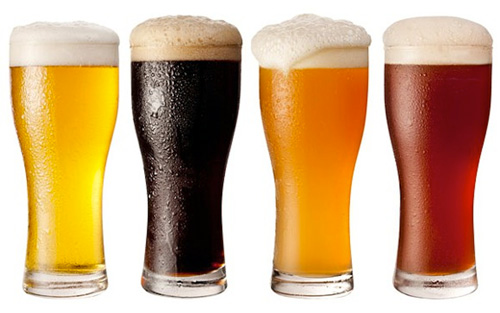
Simply put, the reason why bar owners are replacing S.W.I.L.L. with craft taps is that’s what beer consumers want. The extra 18 minutes he mentions probably comes from the fact that people can’t drink his beer fast enough because it’s ludicrously over-carbonated and they needed 15 of those 18 minutes to belch.
Back to neuroanthropology: why do craft beer lovers reject S.W.I.L.L. ? The article at PLOS is excellent and covers a lot of ground, hinging on the paradigms put forth by anthropologist Daniel Lende, who ‘proposes the following items as useful to understanding what drives consumption: sensorial, corporal, experiential, decision engaging, social, and meaningful.’
All good stuff and there’s a great bit on blind trials using different beer glasses to gauge drinkers responses to actual rather than presumed flavours and aromas, but the two most significant points pretty much cover what drives craft beer drinkers away from S.W.I.L.L. and into better beer, flavour and engagement.
Typical S.W.I.L.L. beer uses very few ingredients (one malt, one or two hops, and some sugary adjuncts), that have low flavour (rice and corn taste like almost nothing after fermentation). The sad truth about these beers is that blindfolded, the most fervent of their partisans cannot tell them apart–they are specifically designed to be as flavourless as possible–offend fewer people, grab greater sales.
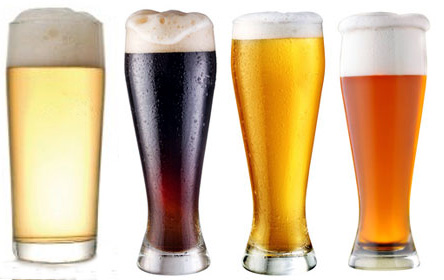
Craft beers on the other hand have the option of using many different kinds of malt–there are hundreds available–and in addition to the explosive growth of new hop varieties, they also add anything that strikes them as a positive–licorice? Sure! Coconut? You bet! And so on. They also use different yeast, and since yeast contributes heavily to the profile of a beer they can really stick the flavour knife in and twist it, adding aromas and flavours of bubblegum, melted butter or tropical fruits, if they desire. S.W.I.L.L. is universally made with alcohol-tolerant, neutral profile yeast.
All it takes is for a lover of beer is to try a few craft beers and as soon as they become normalised to the very different flavours and aromas, all S.W.I.L.L. tastes weak, watery and fizzy. It doesn’t matter if it’s the same alcohol content or the same body, the relatively weak palate of flavours and neutral character makes it wimpy.
Engagement is the second part and it’s the secret key. It’s impossible to engage with a corporation that concentrates of return for its investors above all else–no matter how many small brewers they buy, no matter how hard they try to use those breweries and their beers as a mask to try to cajole people to like their overall portfolio, it won’t work.
I engage with breweries that can tell me an authentic story about their beer–who made it, where the recipe came from, how they feel about it, and what cool stuff they’ve done and plan to do next. A corporation, designed only to make money for investors, doesn’t have a story like that, and as soon as they purchase a craft brewery they destroy its story as well.
And a corporation will never, ever understand why. Because they could be making bricks or shoes, and don’t care what the vehicle for their revenue stream is. Real craft breweries engage their drinkers with not only flavour, aroma and choice, but also with a real dedication to the idea that beer is more than just a drink–it’s a gateway to an experience.
Heading for a State of Grace
“Hawaii is not a state of mind, but a state of grace.” – Paul Theroux

And thats where I’m headed. I’m working on my sixth decade, and despite relative proximity (can’t get much closer to Hawaii and still live in Canada) I’ve never visited the islands. It’s been a cold winter and a terrifically interesting year so far, and I need a break from shivering and hustling.
Sadly I had rotator cuff surgery last week and that means no snorkeling. Quelle dommage! But I’ll muddle through with the help of beaches, waterfalls, musubi, poke, pork and probably a wee tot of rum. Or two.
I’ll be hitting the ground running when I get back. First I’ll be teaching a homebrewing class at Beyond the Grape in Port Moody (want to learn how to do your first brew with grains, hops and extract? Call Michael or click here and get hooked up!)

Right after that it’s the Winemaker Magazine 2014 conference June 5-7th in Virginia. I’ll be teaching a boot camp seminar that will include the use of advanced equipment (vacuum bottle fillers! Home laboratories! Super-secret ingredients!) and top-level techniques for making your best wine ever! I’ve never taught anyone this stuff before, so the folks who attend are going to have secret knowledge!
It’s shaping up to be a busy year. I’m looking forward to it!
The Gospel of Retail
I’ve been in retail for a long time, first as the manager of a big home beer and wine supply store twenty years ago, and later as both a retail coach and trainer to others (while still running a smaller retail store on the side as part of my day job).

I love the business, which is really a thing you need to understand: either you love retail and the whole ‘I have stuff and want to get people to give me money for it because that’s how commerce and most everything works’, or you don’t love it at all, and feel positively sticky about asking strangers to pull out their wallets in exchange for your sordid junk.
It’s okay to be the latter. After all, there are certain aspects of business that I’m ill-suited to myself (accounting, bookkeeping, staying awake in meetings that last longer than 19 minutes, etc) and I avoid them. If you hate retail, you’re probably smart enough to avoid being in a situation where you’re obligated to perform as a retailer.
Unfortunately, some people don’t do that. And it drives me bananas.
I understand if it’s a job and you really need one. Been there, done that, actually shovelled manure for 10 hours a day for minimum wage. But I didn’t do it out of hate, and I understood how the job worked: that end of the shovel went into the muck, and the other end connected to me, and I kept my mouth shut and shoveled and somebody gave me a paycheque. Hating your job (believe you me, I hated that poopy job) doesn’t mean that you let it influence how you perform it. If it does, you’re letting yourself down. After all, if you’re bad at shoveling dung, what else can’t you do in life?
While it’s a sad case when retail employees dislike their job and let it show through inattention, ineffectiveness or pure loathing, it’s much worse when it’s the retail shop owners who are the problem. That’s when things get grotesque. I’m sure that there is nobody reading this who hasn’t had the experience of entering a shop with the clear goal of making a purchase, but has been frustrated out of it by an absolutely dreadful retailer, someone who was either having a bad day and let it loose on you, or someone who simply did not acknowledge that the act of transferring money from you to them, and goods from them to you was the only thing on the agenda.
I could raise a dozen examples I’ve experienced in the last month without even trying, and probably several hundred if you gave me a day (and I didn’t get depressed and quit trying because it’s all so repetitive and awful) but my very worst peeves are when I’m goal-oriented on a purchase to the point of target fixation, where my burning desire is to give money, get the thing and go, but the retailer wants to talk me out of it–‘Oh, those are quite expensive’, ‘That’s the display model’, ‘The new ones are coming out in a few months’, ‘I’ve given up stocking those–we can’t keep them on the shelves’. AAAAGH!

It was on this topic that I ran across a quote in an odd spot today, and as soon as I read it, I knew I had to share it.
The spot was Terry Pratchett‘s Unseen Academicals. For those who don’t know Pratchett, go forth and know his work immediately. He’s a British fantasy author who writes subtly, subversively and hilariously about the human condition, under the guise of a moderately ridiculous fantasy world that rides about on the back of a giant turtle.

It might seem like kid’s stuff at first, but Pratchett is a class warrior, and egalitarian and one of the humanest humanists I’ve ever read. Nine stars and eleven thumbs up for him–if you know and love a reader, give them the gift of Pratchett, posthaste. Ahem.
The quote:
” . . . shops were doing well these days, largely because they understood the first rule of merchandising, which is this: I have got goods for sale and the customer has got money. I should have the money and, regrettably, that involves the customer having my goods. To this end, therefore, I will not say ‘The one in the window is the last one we have, and we can’t sell it to you, because it we did no one would know we have them for sale’, or ‘We just can’t keep them on the shelves, or ‘I’m fed up with telling people there’s no demand for them’. I will make a sale by any means short of physical violence because without one I am a waste of space.“
Yes, yes, YES! The retailer’s target demographic is people with money who are willing to give them some. Nothing else matters, give the people what they want, quickly and efficiently and you’ll be so far ahead of your non-retaily competitors it’ll make your head spin. Just having a store with goods in it and warm bodies doesn’t mean you are a retailer–retailers sell things, period.
And if you’re a retailer, I salute you. You have goods, I have money: let’s talk.
Now if you’ll excuse me, I’m going shopping.
Shout-Out
There’s a new blog in town, and I like it.

Austin Homebrew Supply is a fine shop in my very favorite city in Texas (sorry, Brownsville!)
If you’ve never been to Austin, make haste, for it is a very cool, often strange place, filled with delightfully odd people and a sense of community and solidarity rare in any country, and perhaps a wee bit at odds with the common perception of Texas-qua-Texas. Dang fine barbecue to boot.
I’ve been friends with the folks at AHB for many years, and have always enjoyed their service and style, and now they’ve gone and stretched out to their customers even further. My buddy Adam Lipscomb now does their AHS Brewing Blog. He’s a good writer, and I know he’ll be telling some great stories. I was actually updated in real time when he was making his infamous Frisky Whiskers Tuna Porter, a surefire hit with all kitties.
Check him out and add him to your bookmarks, and you can even drop him a line if you’ve got questions.
In the meantime, relax, don’t worry, and have a nice cool beverage.
